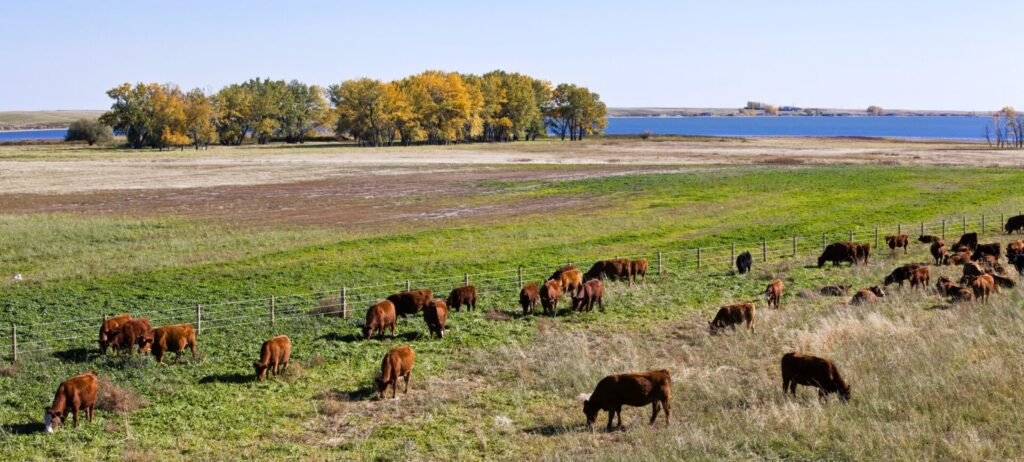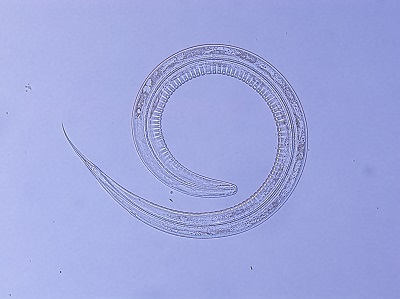When The Worms Come Marching In
This article written by Dr. Reynold Bergen, BCRC Science Director, originally appeared in a September 2022 issue of Canadian Cattlemen magazine and is reprinted on the BCRC Blog with permission of the publisher.

Gastrointestinal parasites are an unavoidable fact of life. Cattle often consume parasitic worm larvae along with the forage they graze. The larvae take up residence in different parts of the digestive system, develop into adults and lay eggs. The eggs are deposited in the feces, where they hatch and release larvae. These larvae eventually leave the fecal pat, crawl up plant stems, get consumed by another animal and the circle of life continues.
Because a great deal of their life cycle occurs outside the host animal, environmental conditions (especially temperature and moisture) can have a significant impact on parasite burdens from year to year. For instance, cold winter temperatures can reduce (but not eliminate) parasite larvae on pasture. As a result, egg numbers on pasture and worm numbers in cattle generally start low in spring, build up over the summer and peak in fall.
A low worm burden is tolerable, but a high parasite load robs the animal of nutrients, draws down body condition score, impacts reproductive and growth performance and lowers its ability to resist other diseases. Internal parasites are generally managed using drugs with “mectin” in the name or active ingredient list, because they’re inexpensive, convenient (especially the pour-ons), and also control external lice. But just like herbicides and antibiotics, using the same parasite product too often leads to the development of resistance and reduced effectiveness over time. There is strong evidence that gastrointestinal worms are becoming resistant to the various ‘mectins.
Dr. John Gilleard (University of Calgary) and Dr. Fabienne Uehlinger (University of Saskatchewan) led a study comparing worm burdens across the Prairies (“Regional heterogeneity and unexpectedly high abundance of Cooperia punctata in beef cattle at a northern latitude revealed by ITS‑2 rDNA nemabiome metabarcoding,” doi: 10.1186/s13071-021-05137-y).
What They Did
In the fall of 2016 and winter of 2017, this team collected fecal samples from nearly 2,500 heifers and weaned calves from 85 herds across Alberta, Saskatchewan and Manitoba that participated in the Western Canadian Cow-Calf Surveillance Network. Fecal egg counts were used to determine the numbers of worm eggs. The eggs were incubated, hatched and new DNA-based techniques were used to identify which species of parasitic worms were present.
What They Learned
Parasite eggs were detected in over 90% of heifers and calves, in 100% of herds. Calves had higher fecal egg counts than heifers (averaging 18 eggs per calf vs. five per heifer), and fecal egg counts were similar regardless of province of origin.

Different species of worms were found in different places. Over 90% of the worms found in Alberta and Saskatchewan heifers were the two species the researchers expected to find based on historical results (Ostertagia ostertagi and Cooperia oncophora). But over 50% of the worms found in Manitoba heifers were Cooperia punctata (followed by the other two species). This was surprising because C. punctata has traditionally been more common further south (e.g., the Midwest and Southern US, South America). C. punctata has also recently been found at relatively low levels in Eastern Canada. This might mean that this species is expanding its range northward and westward. It wouldn’t be the first time – we’ve seen similar things recently among ticks that can carry and spread Anaplasmosis. However, C. punctata is also really skilled at developing resistance to the ‘mectins, so widespread pour-on use may have allowed it to outcompete the other worms and become the predominant species in those herds. In any event, this result is alarming, because C. punctata is more likely to cause disease, depress intake, and impair growth than the historically more common C. oncophora.
So What Does This Mean… to You?
Your herd probably has worms, and they may be silently reducing your pregnancy rates, weaning weights, and increasing your health and winter feed costs. If you haven’t had a fecal egg count done on your herd before (or recently), ask your vet about doing one. This test will help determine whether dewormer treatments are needed, or whether your current worm control program should be modified.
Visit the BCRC’s Internal Parasites webpage for more information about common Canadian parasites, prevention and control measures.
If worms are scarce, you may not need to treat as often. If the parasite burden is high, they may suggest you use a combination dewormer treatment, meaning that cattle receive both the routine pour-on ‘mectin as well as an oral ‘bendazole (e.g., SafeGuard, Panacur or Valbazen). Worms are still highly susceptible to these ‘bendazoles, so a double whammy with two products at the same time (and perhaps again before spring turnout) will help make sure your cattle don’t have to share their feed with parasites all winter. It will also reduce the number of new worms they shed to the pasture the next spring. It’s best to have an fecal egg count done first to save unnecessary drug costs and use. Also pay attention to what the cows can tell you – they’re likely all carrying worms, but the ones that have a high body condition score probably aren’t carrying as many worms. So, you might be able to skip the dewormer(s) on the 10-20% fattest cows in the herd, slow ‘mectin resistance development and save some money.
The Beef Cattle Research Council is funded by the Canadian Beef Cattle Check-Off. The BCRC partners with Agriculture and Agri-Food Canada, provincial beef industry groups and governments to advance research and technology transfer supporting the Canadian beef industry’s vision to be recognized as a preferred supplier of healthy, high-quality beef, cattle and genetics.
Click here to subscribe to the BCRC Blog and receive email notifications when new content is posted.
The sharing or reprinting of BCRC Blog articles is typically welcome and encouraged, however this article requires permission of the original publisher.
We welcome your questions, comments and suggestions. Contact us directly or generate public discussion by posting your thoughts below.